

BOARD OF TRUSTEES
Chairman Bill
Treasurer
Secretary Sandra
President/CEO
TRUSTEE
LEGAL
Brian S. Harnik Roemer & Harnik, LLP
Deborah Chapman *
Susan Cooper
Jeff Elder
Marylynn Gladstein
Phil Hasbrouck
Candace Holzgrafe *
Suz Hunt*
Michael Kiner
Justin McNulty
Jaishri Mehta
Jneil Nelson
Peter Scheer
Sally Simonds
Bill Simpkins
Phillip K. Smith, Jr. *
Mary Lou Solomon
Larry Spicer
Sam Spinello
Nancy L. Stegehuis *
*Board of Directors
Our mission is desert conservation through preservation, education, and appreciation.

The Living Desert Zoo and Gardens is a California 501(c)(3) non-profit public benefit corporation which receives no ongoing municipal tax support (EIN 95-3385354). We are supported solely by the generosity of individuals like you — your ongoing gifts make all that we do achievable. Donations are tax-deductible to the fullest extent possible. For more information, contact Development@LivingDesert.org or 760-346-5694.
Angela Woods PRESIDENT

Managing Editor
Jenny Lynn Robinson
Designer
Phaedra Strecher Heinen
Contributors
Dr. James Danoff-Burg
Sandy McClung
Viviana Martinez
Tim Van Loan
Jenny Lynn Robinson
FROM THE PRESIDENT’S DESK
AT THE LIVING DESERT Zoo and Gardens, every day is a reminder of just how important our mission truly is: to inspire people to care for the world’s deserts through conservation, education, and appreciation of the natural world. As our planet faces growing environmental challenges, climate change, habitat loss, and species extinction — our work has never been more critical. And it’s because of your continued support that we can lead with both passion and purpose.
Conservation isn’t just what we do, it’s who we are. From safeguarding endangered desert species like the Peninsular bighorn sheep and Mexican wolf, to restoring habitats and supporting global conservation initiatives, our impact reaches far beyond our gates. But protecting wildlife is only part of the equation. Inspiring future generations to care, understand, and act is equally vital. That’s where education comes in.
Each year, thousands of children, students, and curious minds visit our Park, wide-eyed with wonder. Whether they’re engaging with an animal ambassador, participating in a hands-on experience like feeding a giraffe, or hearing the story of a species on the brink of extinction, they’re connecting with nature in a way that’s real, meaningful, and lasting. That spark — of curiosity, of empathy, of stewardship — is the foundation of lifelong conservation action. And it starts here at The Living Desert.
Our educational programs are built to do more than inform; they empower. We teach science through the lens of wildlife, conservation through experience, and responsibility through
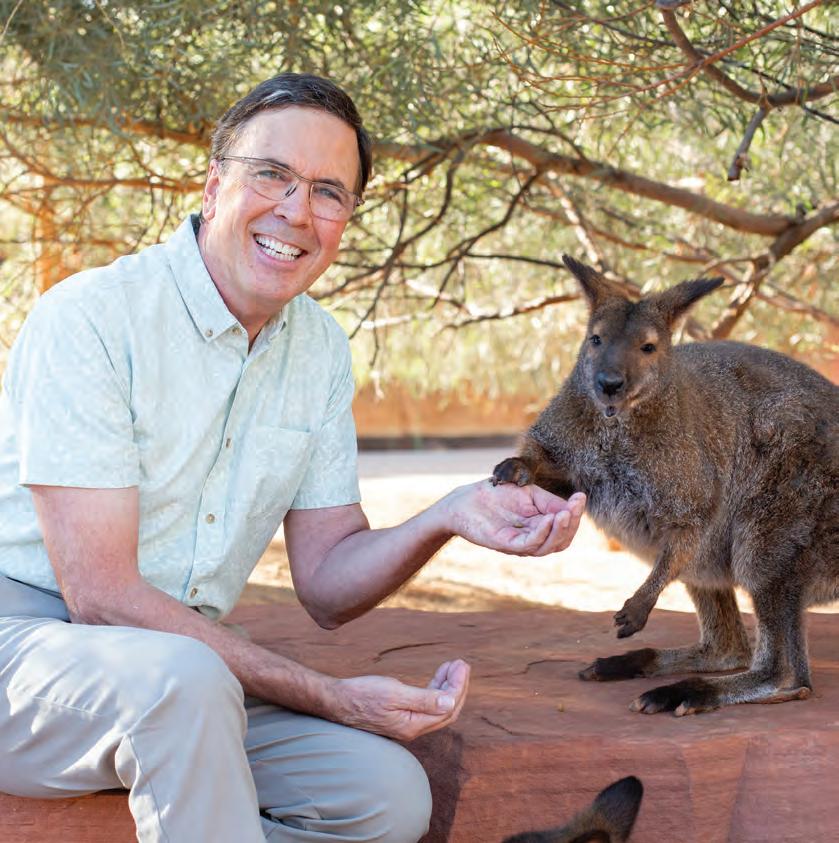
inspiration. In doing so, we’re creating not just future scientists and conservationists — but future advocates and leaders.
As we look ahead, I’m excited about the many ways we’re deepening our commitment to our mission. Whether it’s developing partnerships with other conservation organizations like the International Union for Conservation of Nature (IUCN), growing our conservation programs for headstarting endangered desert tortoises, or finding new and innovative ways to bring nature into
the classroom, we remain steadfast in our belief that education is the pathway to lasting conservation.
Thank you for walking this journey with us. Every visit, every membership, every gift — big or small — helps us protect desert species and landscapes while connecting people to the beauty and importance of desert habitats.
Together, we are building a brighter, wilder future.

Allen Monroe, President/CEO
BCCS participants celebrating the completion of their workshop with local community members and traditional dancers.

IUCN Center for Behavior Change at The Living Desert
by Dr. James Danoff-Burg , Vice President of Conservation
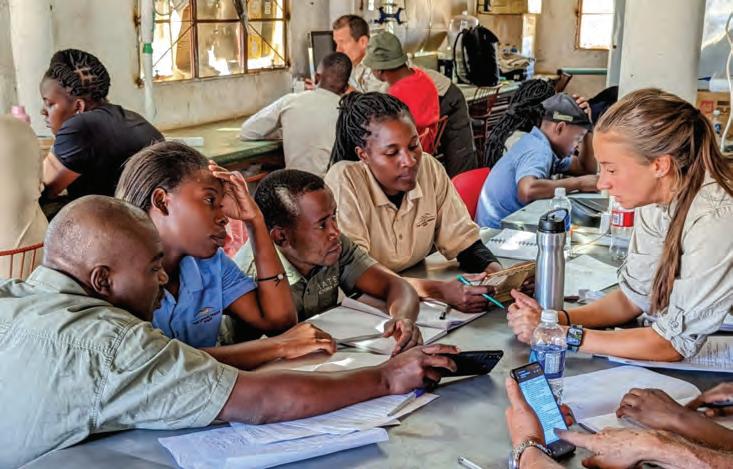
THE CENTER for Species Survival - Behavior Change at The Living Desert (CSSBC@TLD) assists conservation organizations to address the root causes of why species are declining. It was formed in collaboration with the International Union for Conservation of Nature (IUCN) to help address the pressing needs of their member organizations in addressing the human dimensions of conservation around the world. IUCN had been impressed with The Living Desert’s Building Community Conservation Success (BCCS) social science workshops
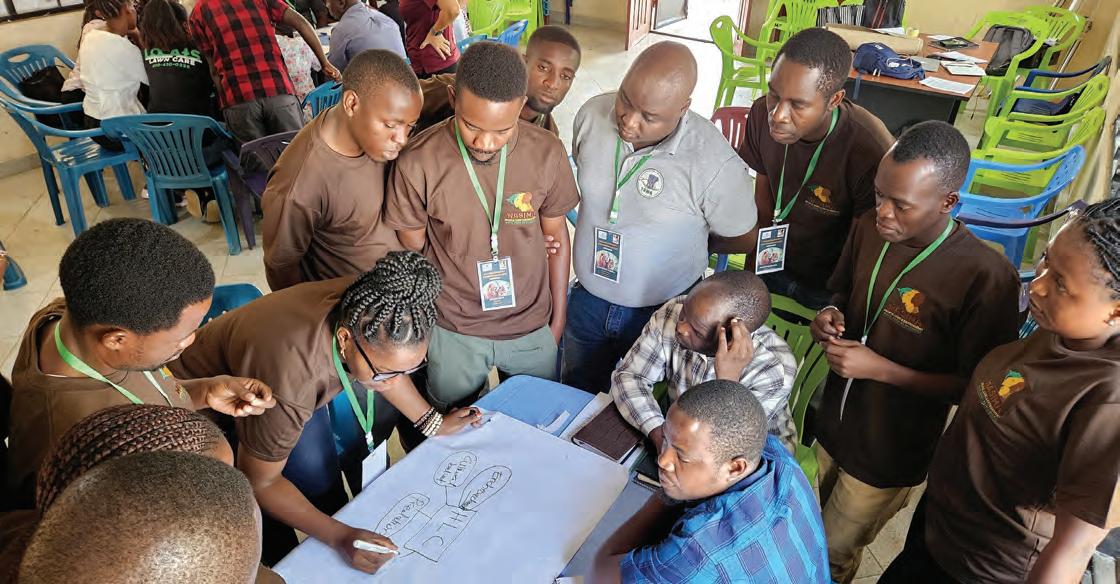
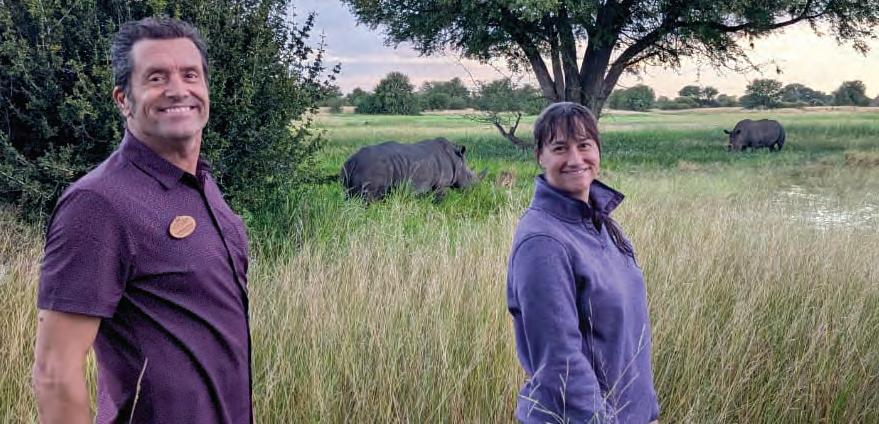
program and we wanted to partner with them to host a Center for Species Survival at The Living Desert.
Species are in decline all over the world not because they forgot how to eat, or breed, or secure shelter. They are declining because of human activities and choices. As such, people are the problem and they can also be the solution — but only with individual and collective behavior change towards sustainability.
The CSSBC@TLD helps advance voluntary behavioral change that
would benefit Indigenous people and local communities as part of community-based conservation. This program helps build capacity among conservationists in deserts around the world to be able to address the root causes of why species are declining and help to reverse the red among IUCN listed species — while also promoting sustainability as people clamor for conservation by directly benefiting from these efforts.
We have had nearly a decade of work in this field and have been actively working in 11 countries to
This ground-breaking program helps build capacity among conservationists in deserts around the world to be able to address the root causes of why species are declining and help to reverse the red among IUCN listed species.
train over 675 conservationists from a total of 32 countries. Their great successes in capacity building help further proenvironment behavioral change.
With the formation of this center, we are going to continue training hundreds of conservationists in the basics of social science through the BCCS workshops, including baseline assessments, formative evaluations, and posthoc impact reviews. We are proud to be helping improve conservation globally with our CSSBC at The Living Desert!

A Fur-Ever Home
From a cardboard box to a desert home, these rescued bobcat kittens are settling into their new home at The Living Desert.
By Jenny Lynn Robinson, Interim Marketing Director
LATE THIS SPRING, on what appeared to be an ordinary day, a local resident outside Eugene, Oregon made a very extraordinary discovery. When they walked out onto their driveway, a small cardboard box sat abandoned and inside was a litter of tiny bobcat kittens. They needed help — and fast. Fortunately, the resident did exactly the right thing and contacted the Oregon Department of Fish and Wildlife (ODFW).
ODFW quickly responded to make sure that the kittens would not be left without proper care. The agency decided finding a fur-ever home for the young bobcats would give them their best possible future.
When The Living Desert received the call, a plan was set in motion within 48 hours to bring the kittens to our facility. On May 1, Renee Barnett, Animal Care Curator, and Wendy Enright, Animal Care Operations Curator, set out on a journey north to Oregon to retrieve the kittens. They safely transported the young bobcats back to California, where a new chapter of their lives was waiting.
CARING FOR THE CUBS
From day one, our animal care team provided around-the-clock care for the kittens. By bottle-feeding every few hours, monitoring their health closely, and nurturing them through those fragile early weeks, the team ensured that the kittens not only survived, but thrived.
Because of the circumstances of their rescue, the cubs, would not be able to return to the wild. Without their mother to teach them survival skills, they would not have the tools necessary to hunt or defend themselves. Here, at The Living Desert, they will live full, enriching lives and act as ambassadors for their species and for desert conservation. ▶
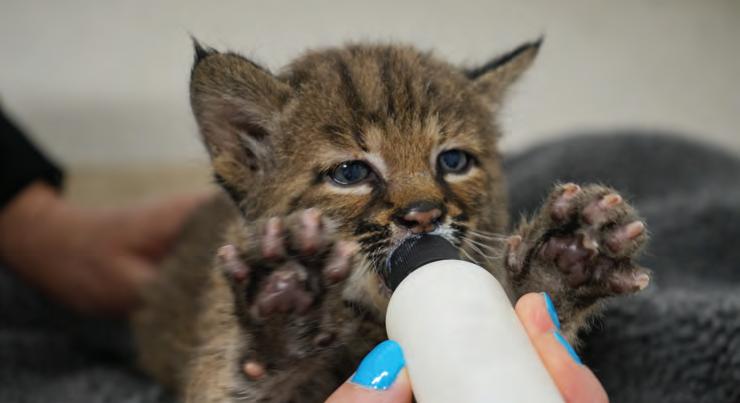
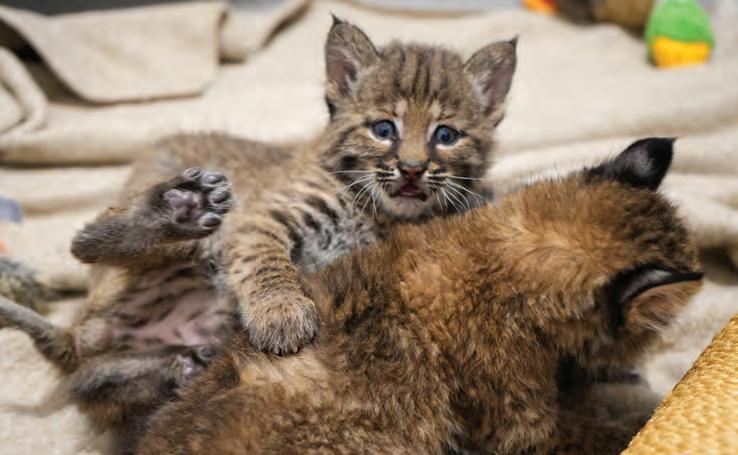
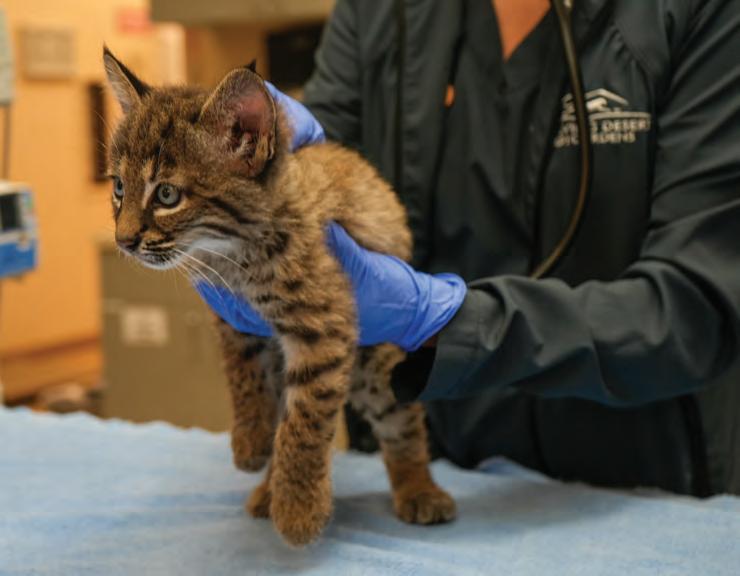


See the kitten cuteness in real time!
Tune in to our LIVE bobcat cam on our website.
LIFE IN EAGLE CANYON
Today, guests can visit the fastgrowing kittens in Eagle Canyon. This immersive habitat offers countless enriching experiences and ways to practice their natural skills: shady caves for hiding, trees and rocks for climbing, and plenty of space to zoom around.
From the moment they arrived, they have been inseparable playmates. But like all kittens, their energy comes in bursts. After a flurry of playtime, the pair often crashes for a well-earned nap. Be sure to check out the den window to spot one of these adorable cat naps!
When you share the habitat, you can help bobcats and local wildlife thrive.
• Supervise small pets when outdoors, especially at dawn or dusk when bobcats are most active.
• Use secure enclosures for chickens, rabbits, or other small animals.
• Avoid leaving trash accessible — bobcats may be attracted to easy meals.
• Be careful when driving at dawn and dusk to help prevent collisions with wildlife.
Every step we take to protect bobcats matters, and as animal ambassadors, David and JoAnn will help millions of visitors understand the vital role bobcats play in the ecosystem and encourage guests to create a better future for all desert wildlife.
The kittens are now named David and JoAnn, thanks to a generous gift from the McGrath family.
MEET THE SIBLINGS
For visitors eager to tell them apart, there are a few subtle clues. Though her personality is anything but small, physically, JoAnn is a bit smaller than her brother. Her coat also has a rust-colored hue, giving her a warm, reddish look. David, on the other hand, has brown fur and a slightly larger stature.
They also approach their surroundings differently! Their Animal Care team has noted that while David tends to eat right away, scarfing down his food in true brotherly fashion, JoAnn prefers to bat and play with her meal before settling in.
“It’s been so rewarding to watch these two grow up and meet their developmental milestones,” says
Animal Care Curator, Heather Down. "It's an honor to share their story and teach guests about the importance of human and wildlife coexistence."
BOBCATS ABOUND
Famous for their tufted ears, short “bobbed” tails, and spotted coats, bobcats are one of the most adaptable wild cats in the world. While they can be found in the forests of Oregon, they can also be found right here in our Southern California deserts! In fact, they can be found in a variety of habitats including mountain ranges, prairies, subtropical swamps, deserts, and the edges of urban areas.
However, despite their resilience, bobcats face threats from habitat loss, vehicle strikes, and human conflict. Predators are a vital part of our ecosystems, and it is essential that we all act as good neighbors to the local wildlife and share the habitat!

What
is enrichment and why is it important?
Enrichment is the process of adding cues and items to an animal’s environment that stimulate their natural behaviors. This is a fancy way of saying, we want animals to showcase all of their amazing natural abilities and behaviors! Animals are capable of so much, and the habitats at The Living Desert stimulate many of those capabilities. When we find that a certain behavior is not being displayed, we come up with innovative ways to help that behavior become part of the animal’s life.
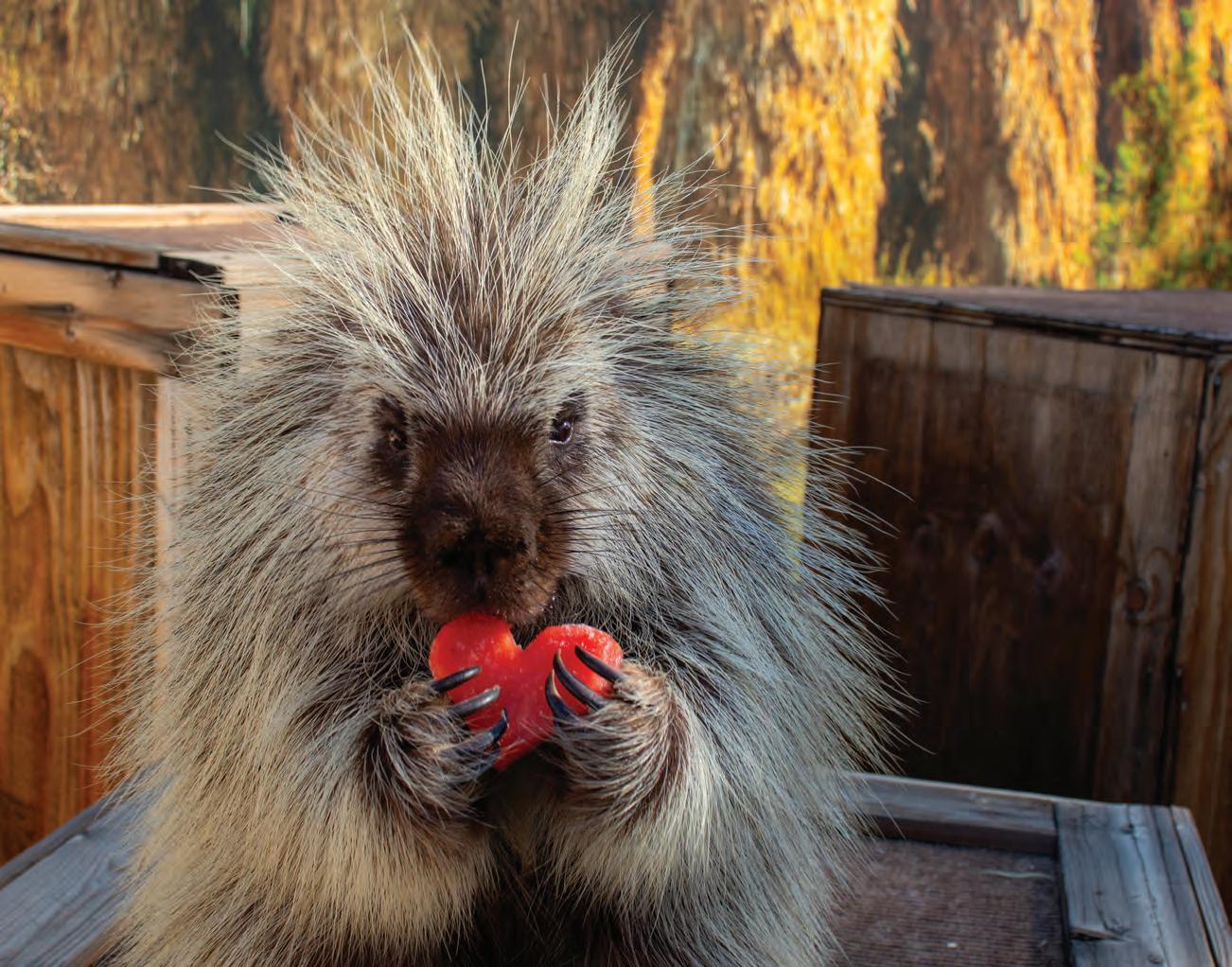
What are “enriched experiences” at The Living Desert?
Animals in the wild go through life exposed to the wonders of the natural world. Everything around them stimulates behaviors and allows them to learn how best to find the things they need. We want to provide those same engaging experiences for the animals at the Zoo, and so our enrichment program is called “enriched experiences.” What we provide goes beyond just toys and items, it is about the full life experience of the animal, and catering to their needs as a species and an individual.
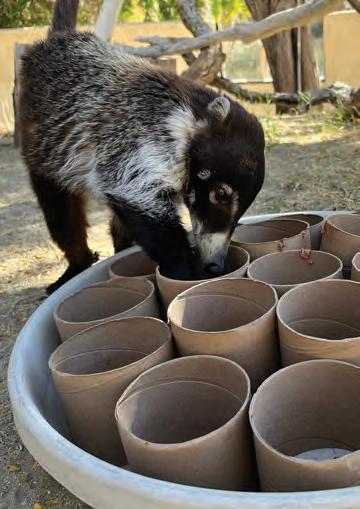
What is an experience?
An experience can be as simple as providing a scent trail that leads to the animal’s food — like how they may find food in the wild — or as complex as a multiday adventure that concludes with a high value opportunity, like a watering hole or a whole prey item. By teaching animals that certain cues lead to greater rewards, they engage with their environment more fully and are more comfortable.

Why do some experiences incorporate human holidays?
You may wonder “why does a tegu need an Easter egg?” The answer might surprise you! While the Easter egg enables guests to celebrate the season and connect with wildlife in a new way, more importantly, it provides an opportunity for the tegu to showcase her natural abilities: cracking the egg and devouring a high value food item. This is an example of how both humans and animals can share and enjoy the same enriching experiences.
How do you know what the animals want and need?
First, we look at the natural history of the species and scientific research. Then, we look at the actual animal in front of us. It is important to balance what the species needs with what the individual needs.
What experiences do you provide to the bobcat cubs?
Hunting is fundamental behavior for all bobcats, and is a skill taught by the mother to her babies. Since the bobcats at the Zoo were orphaned, we provide experiences that help them learn what hunting actually entails. This means creating blood trails that lead to food, breaking twigs and placing fur or feathers on them to show how to track prey, and leaving whole prey items in locations that require some work to attain.
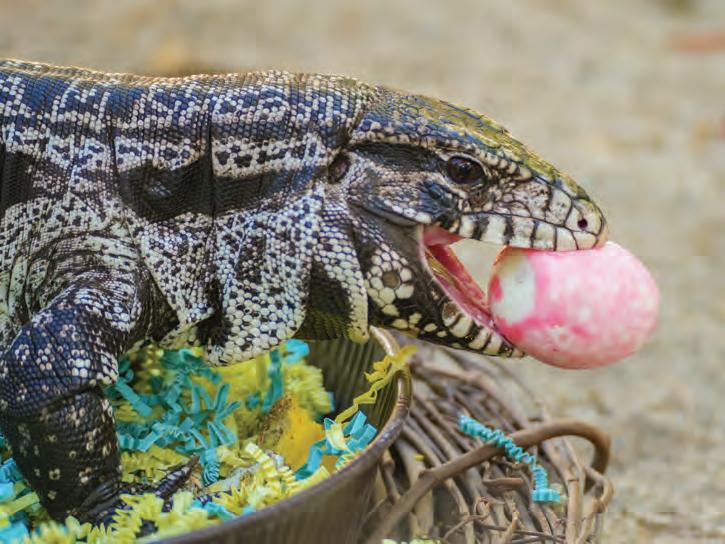
Just like humans, every animal is different, with its own preferences and behavior, and so we cater to them to give them what their actions tell us they need.
How do you decide which behaviors to target?
The Living Desert has a team of expert keepers and behavior specialists, who observe animal
behavior every day, in every interaction we have with an animal. We pair that with scientific data, called activity budgets, that tell us how animals spend their time in the wild. By comparing the two, we can find areas where we can change animal behavior to more closely match wild animals or even add and eliminate behavior, as needed. ▶
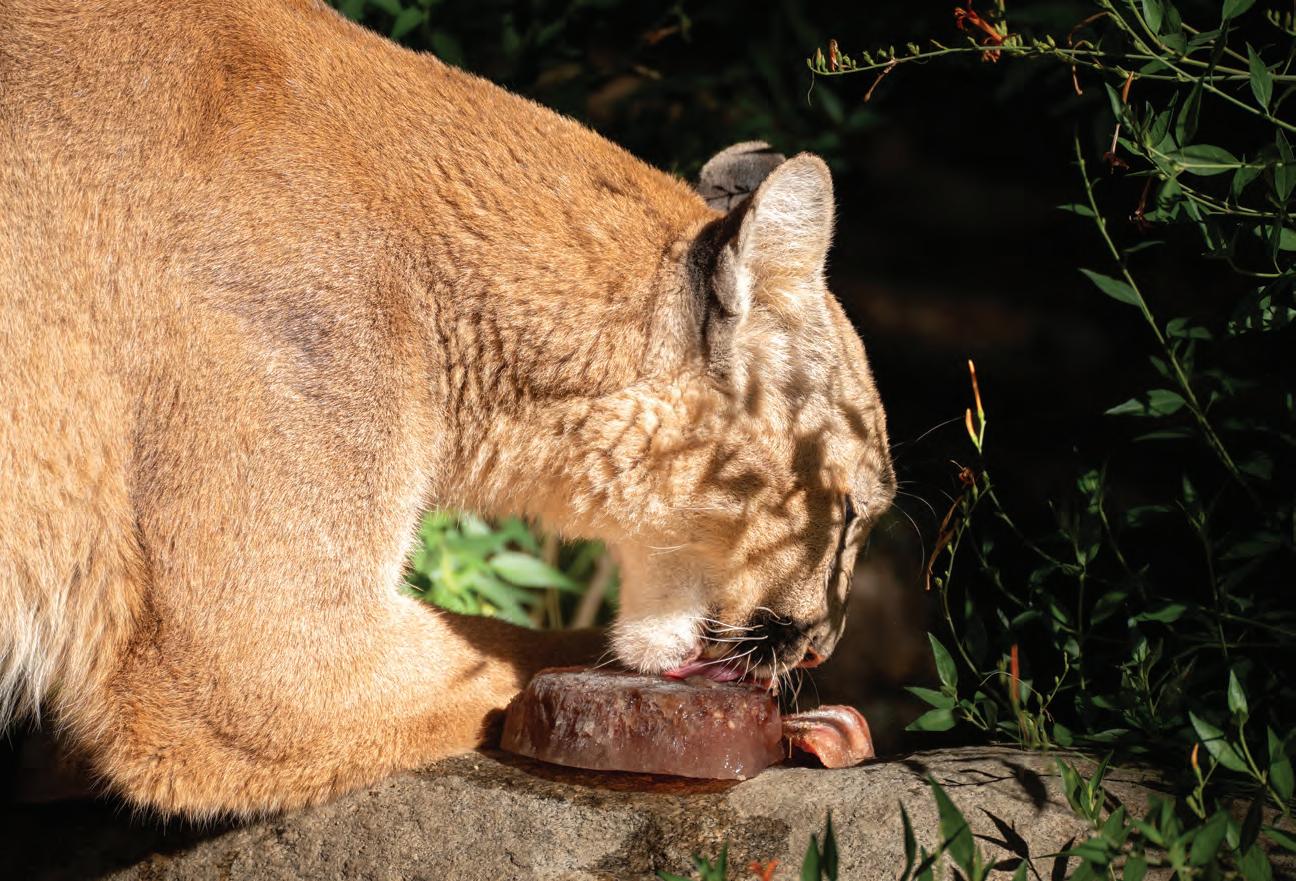
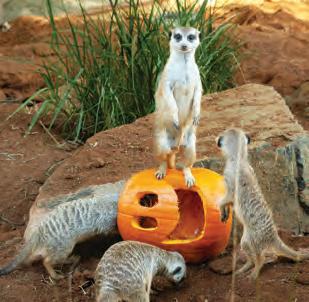
So, it is not just about food?
Food and foraging behavior are foundational parts of an animal’s life experience. Plus, every animal has to eat! So, food does play an important role in providing experiences for animals. That being said, there is so much more in an animal’s world that dictates their life. We want them to experience complex social interactions with others in their species, and animals of other species, which is why The Living Desert has so many multispecies habitats. We want animals to use their locomotion abilities, which is why habitats have varied terrain, landscaping, and thoughtful opportunities to climb, jump, fly, and more. We look at all aspects of an animal’s life, including food, to find the experiences that will engage them the most.

Why does The Living Desert only use naturalistic enrichment?
Animals do what they do best every day in the wild. By providing naturalistic enriched experiences, we are mimicking the wild experience and giving guests the chance to envision how amazing animals are in their daily lives.
How do experiences change with the seasons?
Seasons in the wild control many of the behaviors that animals need to survive. So we use the seasons to our advantage to create meaningful opportunities for the animals at The Living Desert.
When it is hot, we provide shade and a variety of ways to cool down. We also offer seasonal food items, like the ice treat Rose, the mountail lion, is enjoying on the left. When it is cold, animals get choices of nesting materials and dens to sleep and stay warm. We may even cover or burry the dens so the animal can excavate the shelter themselves, like they would in the wild.
What
are some surprising types of experiences?
One of the most surprising might be a territory defense experience. Through every experience, we first ensure the safety of the experience and that we are not creating undue stress. With territory defense, we provide cues, like scents and sounds, that would tell an animal that another animal might be moving in on their home range. By stimulating animals in this way, we draw out new behaviors, such as contact calling, patrolling, and resource/ food storage, all of which can occupy animals in a healthy way for long periods of time.
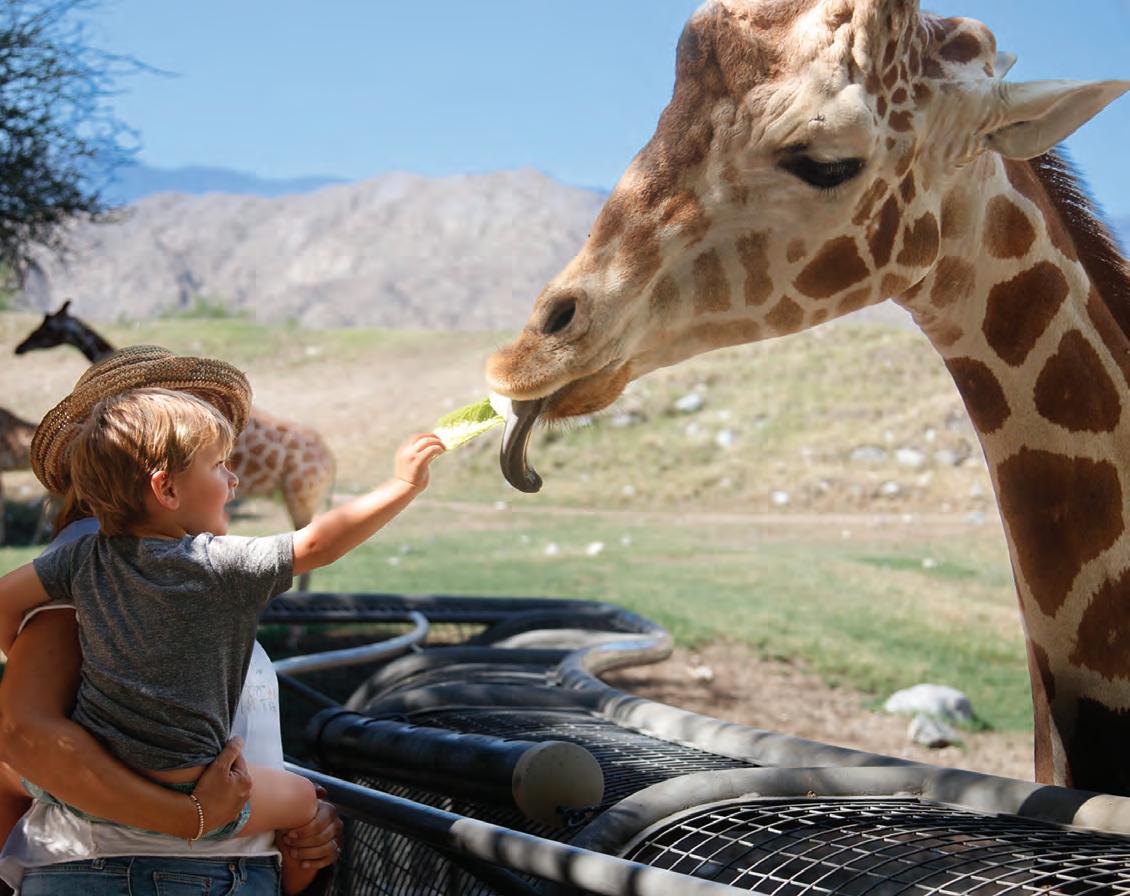
Are human-animal interactions, like the rhino encounter or giraffe feeding, enriching experiences?
Absolutely! When you participate in an animal interaction, you are helping to provide a stimulating, unique experience to that animal. You get to see the animals up close, and they get to show off what makes them so special!

Are animal training and experiences related?
Animal training is a form of an enriched experience. During animal training sessions, animals are taught new behaviors, or existing behaviors are enhanced to help them better adapt to life at The Living Desert. We work closely with the animals to ensure we have positive, engaging relationships through cooperative training by utilizing the behaviors that make animals so skilled!
WILDFILE
WELCOME HOME
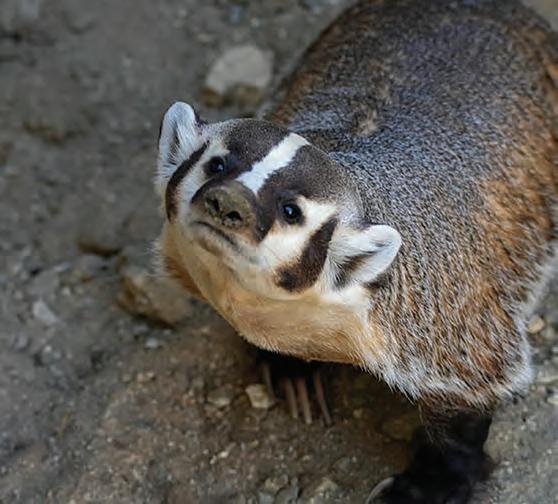
Spock, the American Badger
Spock is a spunky three-year-old American badger who recently joined us from the Dakota Zoo in North Dakota. True to his nature, he loves to do what badgers do best — dig, dig, dig! With impressive speed, badgers can disappear underground in just seconds. Since settling into his new home at Eagle Canyon, Spock has made wonderful progress in training and grown confident and comfortable with his animal care team.
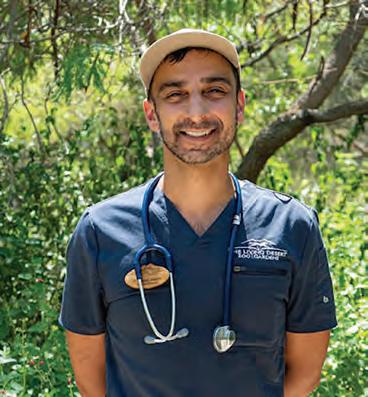
Maybelline, the Southern Ground Hornbill
Maybelline (lovingly called “Mabel”), is one of the newest residents of The Living Desert. She is a striking five-year-old southern ground hornbill, the largest of the hornbill species. These impressive birds are known for their vivid red facial color and spend most of their time on the ground. They hunt insects, reptiles, small mammals, and even other birds. Mabel has her own gourmet favorites: superworms, hornworms, and dubia roaches — talk about a refined palate!

Use your phone’s camera to scan the QR code and see this photo come to life!

Dr. Yousuf Jafarey
Also new to the Zoo, is Dr. Yousuf Jafarey who has joined the team as our new Senior Veterinarian. Dr. Yousuf brings over 13 years of experience in zoological medicine across four AZA-accredited facilities. Dr. Yousuf has a strong professional interest in infectious disease management, anesthesia of megavertebrates, and reproductive biology. He is passionate about interdisciplinary collaborative care.
Previously, he co-managed the Animal Health and Nutrition Department at the Jacksonville Zoo and Gardens, where he strengthened cross-departmental collaboration and oversaw nutritional strategies for a diverse collection. Dr. Yousuf is excited to return to a leadership role where he can continue to foster integration between animal health, husbandry, and operations. Welcome to your new zoo "home," Dr. Yousuf!

For the first time ever, The Living Desert will welcome a primate species! We are thrilled to announce that a group of patas monkeys will be joining us in Village WaTuTu, with their grand opening set for November 1. Get ready to celebrate the arrival of these new residents with us and watch them explore their habitat!
The Patas Monkey Conservation is generously supported by Squire and Angela Junger. Yes, there are desert primates... and THEY'RE ARRIVING THIS FALL!
WILDFILE
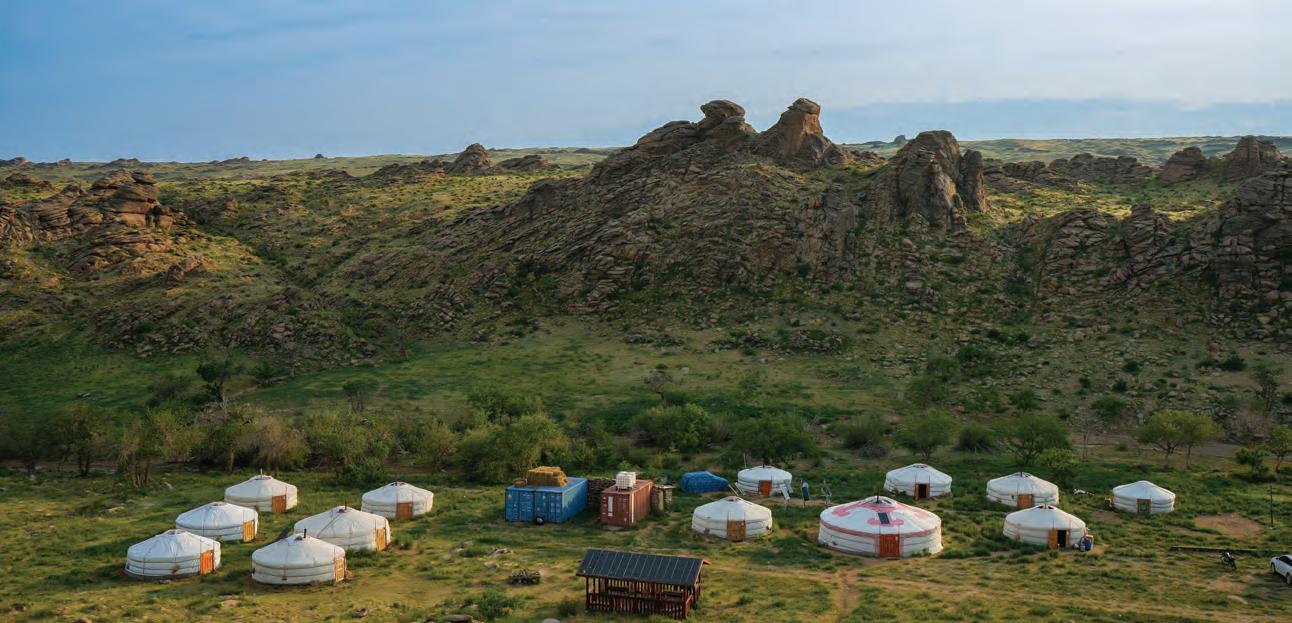
Connecting Classrooms to Conservation
and
Empowering Desert Defenders Across the
Globe
By Viviana Martinez, Learning Engagement Coordinator
The Living Desert’s partnership with the Mongolian Conservation Initiative (MCI) has pushed the boundaries of conservation, bridging two strikingly similar deserts on opposite sides of the globe and connecting children to their local deserts. Over the past year, this partnership has grown through staff exchanges and joint efforts to bring hands-on learning into classrooms and community spaces, giving students the chance to practice science, gain confidence, and advocate for the world around them.
Last year, members of the MCI team visited The Living Desert to observe how we design our educational programs. We created a program for our 2024 Fall ZooCamp where participants explored the Sonoran Desert using field techniques practiced at the Ikh Nart Nature Reserve in Mongolia. The California students were thrilled by every experience. They explored natural substrates for signs of wildlife, learned animal identification by visiting the Zoo’s warthogs, and conducted plant counts and restoration work to apply their new conservation skills.
Months later, I had the opportunity to travel to Ikh Nart and work directly with the local rangers and staff to help implement this active learning project.
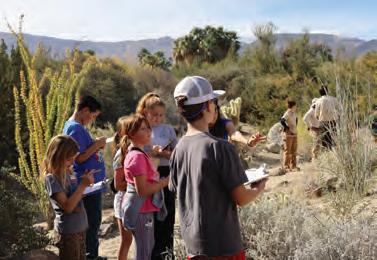
Together, we discussed and tested which activities would work best in their setting, balancing handson engagement with the rangers’ teaching styles. Students then learned about animal interactions with taxidermied specimens, created wing tags to help track cinereous vultures, conducted plant surveys to understand how the animals used the land, and went on nature walks to sharpen their observational skills. Through each activity, we encouraged them to consider ways they could advocate for and protect wildlife.
One of the most rewarding parts was seeing the Mongolian children’s excitement grow as they learned about and explored Ikh Nart. On the nature walks, I encouraged them to look closely for small details that could give us a hint to the incredible wildlife sharing the reserve. We saw stunning minerals and bone fragments, plenty of scat, massive vulture nests atop the trees, and speckles of colorful flowers. For many, it was their first chance to experience the natural world this way, and their curiosity blossomed.
Moving into the future, our team will continue working alongside MCI and their youth programs, supporting the Ikh Nart team in further adopting hands-on methods for large school groups, providing additional training for classroom teachers, and expanding opportunities for older students. Later this year, a different group from the Mongolian team will visit The Living Desert to see our programs in action once again. Through this work, we hope to inspire curiosity, nurture a love for nature, and instill the confidence students need to create change.
THE RACE TO SAVE CHEETAHS

Introducing an event venue of an entirely different animal — The Living Desert Zoo and Gardens!
From lavish cocktail parties and dinners to intimate receptions and ceremonies, adventerous corporate events, meetings, or picnics, The Living Desert offers a setting unlike anywhere in the Coachella Valley.
For more information and to book a complimentary site tour, call 760-346-0301, or visit LivingDesert.org/PrivateEvent.

Discover a wildlocation for any occasion

The Living Desert is dedicated to educating the next generation of conservationists, safeguarding desert habitats, and ensuring the cherished desert species we love can thrive for generations to come.
Did You Know?
You can also give stock, grants from Donor Advised Funds, or make a Qualified Charitable Distribution (up to $108,000) to maximize your tax benefits! These forms of giving are often more “tax-smart” than cash donations. Contact Donna Raider at (760) 674-4896 or DRaider@LivingDesert.org
ALEX GLICKMAN AND GAYLE WHITTEMORE
Supporter Spotlight
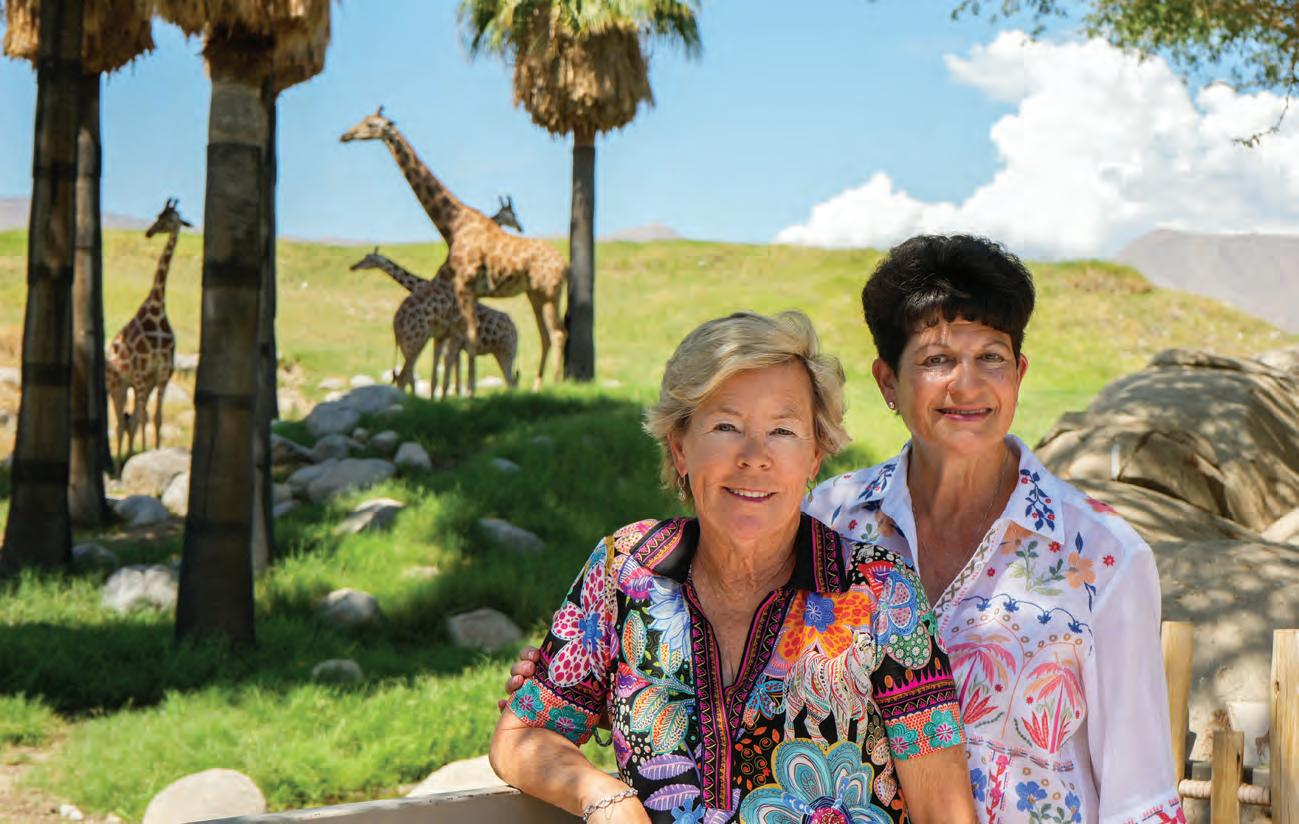
ALEX GLICKMAN AND GAYLE WHITTEMORE, married for 14 years, have created a strong tradition of enjoyment and support for The Living Desert with their combined family of 4 adult kids and a 7-yearold grandson.
“The openness and constantly evolving habitats have always brought joy to our family,” says Alex, the Global Head of Real Estate and Hospitality for Gallagher, a Fortune 500 company. Her wife Gayle, now retired from a successful career as a CPA and CFO of several large non-profits, shares her commitment to the mission of The Living Desert. While they have been generous supporters for many years, in 2025 they united their passion for two additional communities they deeply care about with their ongoing support of The Living Desert.
Alex proposed the idea of PRIDE for the Pride (P4TP), a fundraising initiative that supports The Living Desert’s capital campaign effort to bring African lions to the Zoo and raise awareness of their critically endangered status. P4TP is a way for the LGBTQ+ community to take part in supporting this
effort as a unified, powerful group. “A pride of lions represents strength and resilience, which we believe also speaks to the LGBTQ+ community. We need our vibrant community to understand the value and impact that The Living Desert brings,” says Alex. To encourage interest and participation in PRIDE for the Pride, Alex and Gayle have established a $25,000 match, that will double the impact of P4TP donors. Additionally, Alex and Gayle feel a keen sense of commitment to military families, as their son-inlaw was a career Marine who spent many years stationed at MCAGCC 29 Palms. To support the families there, they have recently donated $10,000 to fund family memberships, as a tribute to their sacrifice.
Alex and Gayle are such a wonderful example of truly dedicated donors and supporters who have found ways to combine their passion and support for many worthy and diverse causes, ensuring that their philanthropy will have an even larger impact. We are grateful to have them as part of The Living Desert family.
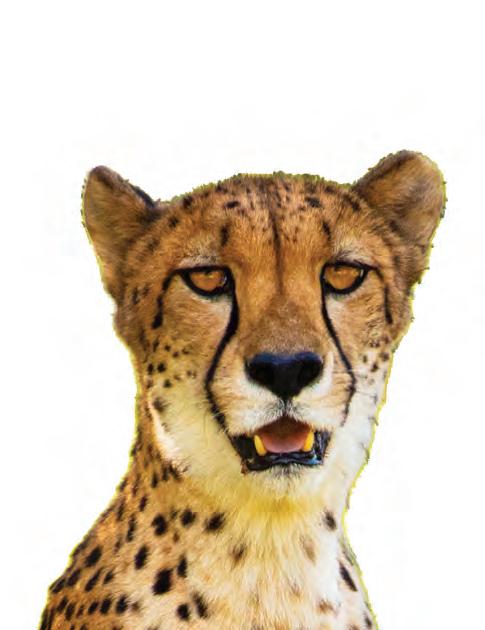
is a Cat A Cat
When is a BIG Cat, not a “Big Cat”?
If you guessed the classification was based on size, you might be surprised to find out the major differentiator is actually the ability to roar! All cats have a bone in their throat, called the hyoid bone, that connects the roof of the mouth and the tongue. For big cats, like African lions, jaguars, and leopards, this bone is soft and flexible, enabling them to make a roaring sound. In small cats, the hyoid bone is hard and rigid, which means they purr instead of roar.
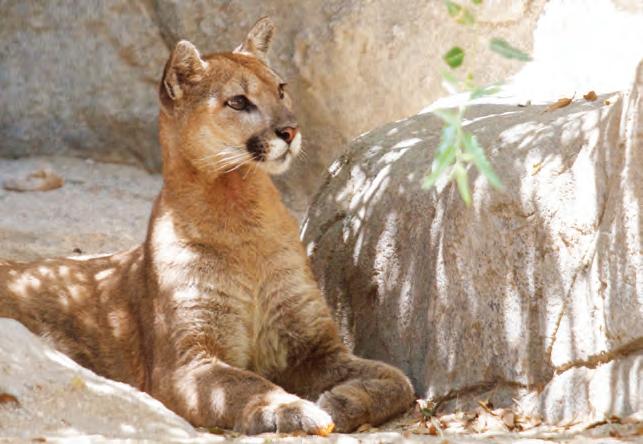

Don’t let size fool you! The smallest feline species, the black-footed cat, is statistically the top-ranked hunter of all cats. While the African lion, one of the largest cats, is the lowest-ranked hunter.
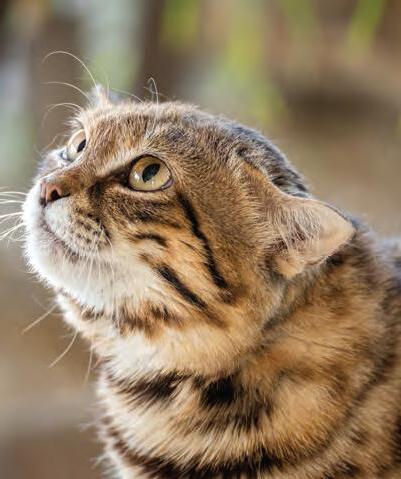

Cute? Yes! But not a pet!
Owning exotic animals can put them in serious danger. Many suffer or die in the illegal pet trade, often during transport. Here’s how YOU can help!
Break up with the bad
Clean up your social media follows! Unfollow, unsubscribe, and report any suspicious content. Then, follow institutions accredited by the Association of Zoos and Aquariums, like @TheLivingDesert, and legitimate rescue organizations instead!
Beware of what you share
Look at a page’s credentials before engaging so you do not accidentally bring positive attention to or demonstrate approval of inappropriate ownership of wild animals.
Limit what you “like”
Engaging with a post can popularize and increase demand for exotic pets and wild animal interaction. By avoiding your engagement with posts, you can limit their reach (and potential profits).

From
Sofa to Savanna: What all cats have in common
Carnivores to the core
Whether it is paté in a dish or a fresh catch in the grasslands, meat is always on the menu.
Chasing champs
From batting after a string to sprinting after an antelope, all cats are born to chase.
Territory markers
Caught your housecat scratching the couch? They have the same instincts that drive a mountain lion to scratch a tree — scent marking their turf.
Super sniffers
Cats have an amazing sense of smell. Your cat uses it to track down treats, while wild cats rely on it to find their next meal.

Ghost Desert
by Dr. James Danoff-Burg , Vice President of Conservation
IMAGINE A WORLD bursting with life, where endangered animals not only survive but thrive in their natural habitats! This is the inspiring vision driving the remarkable efforts to reestablish a healthy population of Sonoran pronghorn in the Chuckwalla National Monument, just east of the Coachella Valley, in Southern California. Once hunted to the brink of extinction nearly a century ago, these majestic creatures are on the verge of a comeback, thanks to a dedicated initiative funded by the U.S. Fish and Wildlife Service (USFWS) and led by the California Department of Fish and Wildlife (CDFW). This ambitious project is meticulously preparing the landscape and uncovering the essential insights needed for the successful reintroduction of these magnificent animals.
The success of this project hinges on two interconnected and equally vital phases: careful preparation of the reintroduction site through thorough feasibility studies and advanced data analysis, and a deep scientific understanding of the factors that influence pronghorn survival. Together, these elements will guide future management decisions and pave the way for a brighter future for the Sonoran pronghorn.
LAYING THE GROUNDWORK: The Feasibility Study and Site Characterization
The initial phase of the project is a comprehensive feasibility study aimed at understanding and preparing the Chuckwalla Bench area for the pronghorn’s return. The Living Desert began this exploration with a series of intense site visits, where researchers traveled to twentyone locations along main roads to characterize the area. During these visits, our scientists carefully documented both the physical features and biological components of the landscape. In this striking landscape, we recorded all the
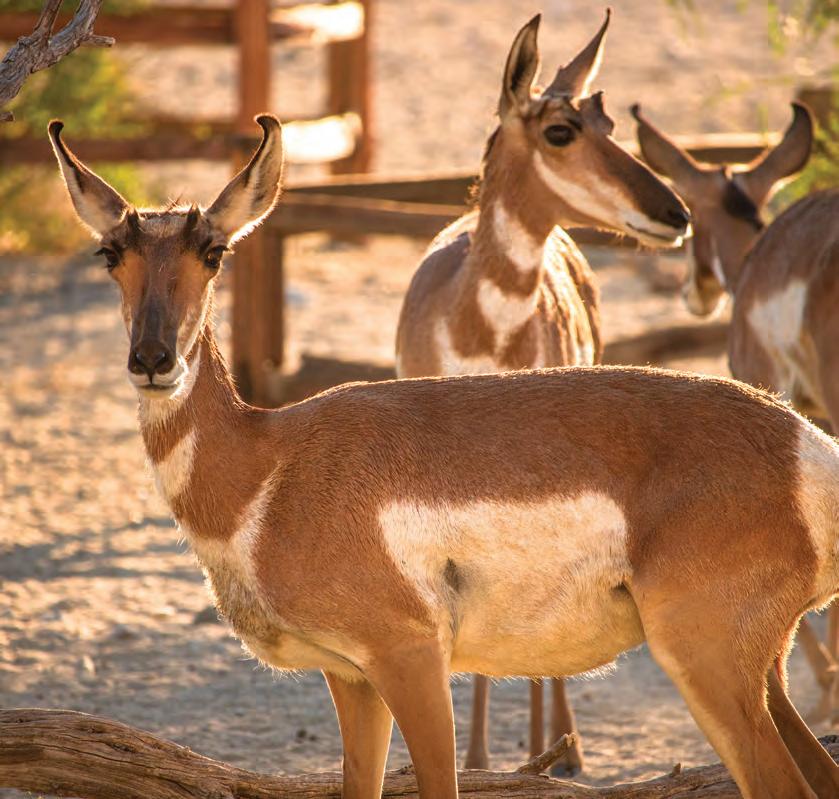
Did you know?
essential physical and geological attributes including all the human created ones like development and solar projects.
Simultaneously, we aggregated biological components to provide a holistic view of the habitat. The Chuckwalla Bench is extremely biologically diverse, so the species that make up the plant communities are jaw-dropping, particularly for an area as dry as this. Also, we needed to see how natural communities have been affected by human activity, including direct activities like illegal hunting and damaging roads and indirect activities like the spread of non-native invasive plant species.
A crucial realization early in the project was that traditional ▶
Once hunted to the brink of extinction nearly a century ago, these majestic creatures are on the verge of a comeback.
The multifaceted approach of the Sonoran pronghorn project exemplifies our passionate commitment to conservation.

vegetation maps alone were inadequate and often inaccurate indicators of habitat quality for Sonoran pronghorn populations. Since these animals require vast territories to thrive, we conducted numerous meetings with the broader Sonoran pronghorn recovery and California reintroduction teams. These collaborations are vital in establishing better parameters to support management decisions during the preparatory phase and
in ongoing monitoring after the animals are released.
THE ROLE OF GEOGRAPHIC INFORMATION SYSTEMS
A significant aspect of this preparatory work is a large Geographic Information System (GIS) project. Our team has actively collected and compiled a wealth of spatial data from the Chuckwalla Bench area, including aspects ranging from the soil erosion potential to roads and
Our comprehensive strategy paves the way for the Sonoran pronghorn’s triumphant return, transforming a vision of survival into a lasting story of thriving in their historic homeland.
plants present to the locations of water sources both natural and artificial.
This extensive spatial data will help develop predictive models, forecasting where the Sonoran pronghorn will likely roam and how they will navigate their landscape upon reintroduction. Once the pronghorns are released, tracking their movement will further refine these models, enhancing our understanding of their habitat needs and preferences within this unique ecosystem. Our team has compiled and analyzed georeferenced spatial data, providing invaluable insights for collaboration with federal and other partners.
WATER SOURCE EVALUATION: A Critical Task
An ongoing and intensive challenge involves evaluating the condition of water sources — known as drinkers and guzzlers — across the Chuckwalla Bench. We inspected drinkers in the northern part of the bench, but a significant hurdle is that only those accessible to small wildlife have been found so far. This means that potential drinkers for the Sonoran pronghorn still need additional assessments. With approximately 200 drinkers in the greater Chuckwalla Bench area, this vital work will continue. The team is already in discussions with the California Sonoran pronghorn group to identify and prioritize areas for drinker assessments before the animals are released.
The long-term goal? To be fully prepared for the reintroduction of the Sonoran pronghorn into Chuckwalla Bench soon! Regular meetings with the Sonoran
A New SAFE Species
The Living Desert is proud to announce the launch of the AZA SAFE program for the Peninsular pronghorn, co-led by Mike Barnes, Director of Animal Care, and Dr. Luis Ramirez, Curator of Conservation. This program aims to support the species’ survival by providing financial, husbandry, management, and veterinary assistance to the last wild population at El Vizcaíno Biosphere Reserve in Baja California, Mexico. The program will also leverage the AZA-managed population to raise awareness, serve as an assurance population, and help secure the future of this critically important desert species.
pronghorn group, primarily based in Arizona, ensure consistent progress and that project results are shared and understood.
RECENT DEVELOPMENTS AND WORKSHOPS
A recent development that adds excitement to this initiative was our Curator of Conservation, Dr. Luis Ramirez’s attendance at a specialized workshop in Yuma, Arizona. This workshop focused on predictive models for Sonoran pronghorn habitat, led by experts from the Aldo Leopold Wilderness Research Institute. The aim? To enhance and refine models assessing current and potential future habitats across the species’ historical range in Arizona and California. A key takeaway from analyzing these models, which were developed using data from collared animals in Arizona, is the critical understanding that successful reintroduction efforts in California depend significantly on improving and expanding water sources
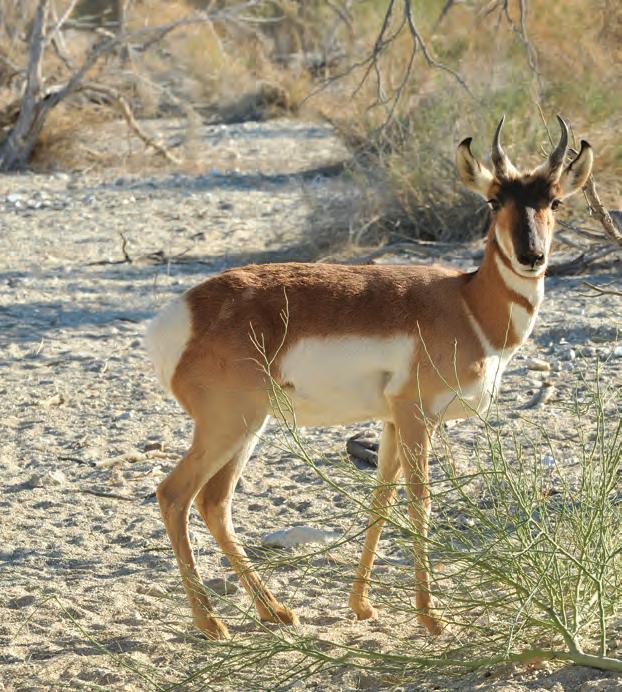
throughout the Chuckwalla Bench area — a key task on which we were focused.
Given the unique ecological features of this region, a reliable and sufficient water supply is essential to support the newly reintroduced pronghorn. Therefore, upgrading existing water infrastructure and finding new sources is crucial to ensuring these animals have the resources they need to survive and thrive. Without these key improvements, the reintroduction could face significant challenges. Plans are underway to collaborate with USFWS staff in California and the new CDFW pronghorn and elk program leader to identify optimal locations for new or enhanced water sources while minimizing potential negative impacts on desert tortoises. This is vital because increased water sources might attract predatory ravens that could threaten tortoise populations.
CONCLUSION
The multifaceted approach of the Sonoran pronghorn reestablishment project in the Chuckwalla Bench, California, exemplifies our passionate commitment to conservation. By effectively combining thorough feasibility studies and advanced spatial modeling with innovative research into survival factors, our work is laying a solid foundation for success. The insights gained from detailed site assessments, along with the critical importance of improving water sources and a deep understanding of how drought, human impact, and individual experience influence pronghorn survival, will directly guide decisions for a successful and enduring reintroduction. Our comprehensive strategy paves the way for the Sonoran pronghorn’s triumphant return, transforming a vision of survival into a lasting story of thriving in their historic homeland.
Bringing the Coachella Valley to Miniature Life
By Sandy McClung, Curator of Volunteer and Interpretive Programs
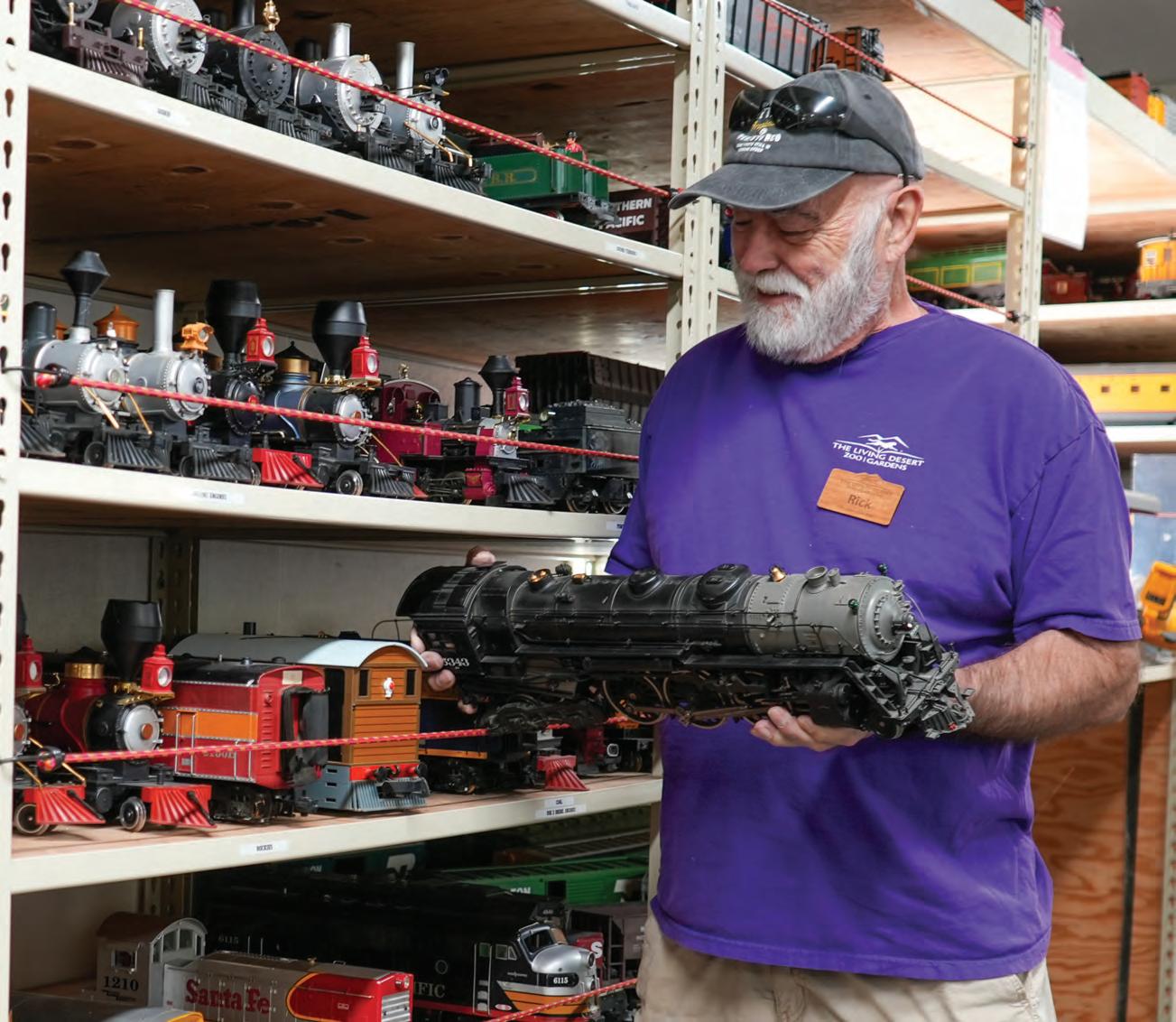
WHEN THE LIVING
DESERT
made the exciting decision to reimagine the Bighorn Railroad to reflect the Coachella Valley, it came with a unique challenge: how do you recreate the region’s most iconic landmarks — at a fraction of the size?
Thankfully, the answer was found in the dedication, talent, and creativity of the Zoo’s incredible Trains Volunteers. With a variety of backgrounds and skillsets, the
team was ready to take on the ambitious task of building detailed, scale-model versions of local landmarks for the beloved exhibit.
The process began with research — and lots of it. Volunteers and staff pored over photos of each building, examining details from every angle. Often, you would find these images tacked up around the Train Depot, where they served as reference material for planning. From there, volunteer Rick led the charge,
How Volunteers Transformed the Bighorn Railroad into a Local Landmark Showcase
using the images and any additional online resources to draft detailed architectural blueprints by hand.
Next, those blueprints were traced onto plywood. With help from our maintenance team, the various pieces were carefully cut out and returned to the Depot for assembly. Following Rick’s plans, the volunteers nailed, glued, and shaped each piece to begin forming a structure that closely mirrored its real-life counterpart.


But it is the detail work that truly brings the buildings to life. Each model was painted to match the original, with painstaking color matching and hand-painted finishes. Roofing materials — such as miniature slate tiles, corrugated metal, or stone-like laminate — are selected or custom-made to match the textures and finishes of the actual buildings. Even plants, signage, and other exterior accents are crafted or 3D printed to ensure accuracy. Finally, the structure was
mounted on cement board and installed in its designated spot on the trains layout.
Each building requires an estimated 40 to 80 work hours to complete — an incredible investment of time, skill, and passion. We extend our heartfelt thanks to our remarkable volunteers who continue to pour their talents into making the Bighorn Railroad a true celebration of the Coachella Valley.
Want to support the Bighorn Railroad?
Become a Main Street Supporter by adopting a building in the Trains exhibit. For those interested in showcasing their business as part of the miniature Coachella Valley, sponsorship opportunities are available.
Please contact our team at Development@LivingDesert.org to learn more.
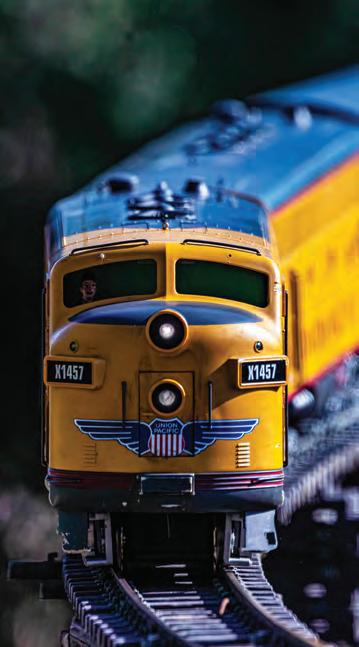
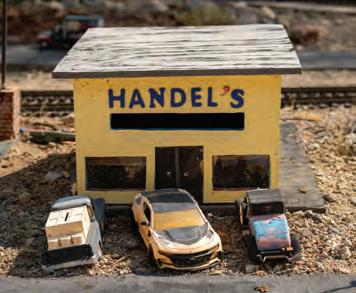
Membership Moment
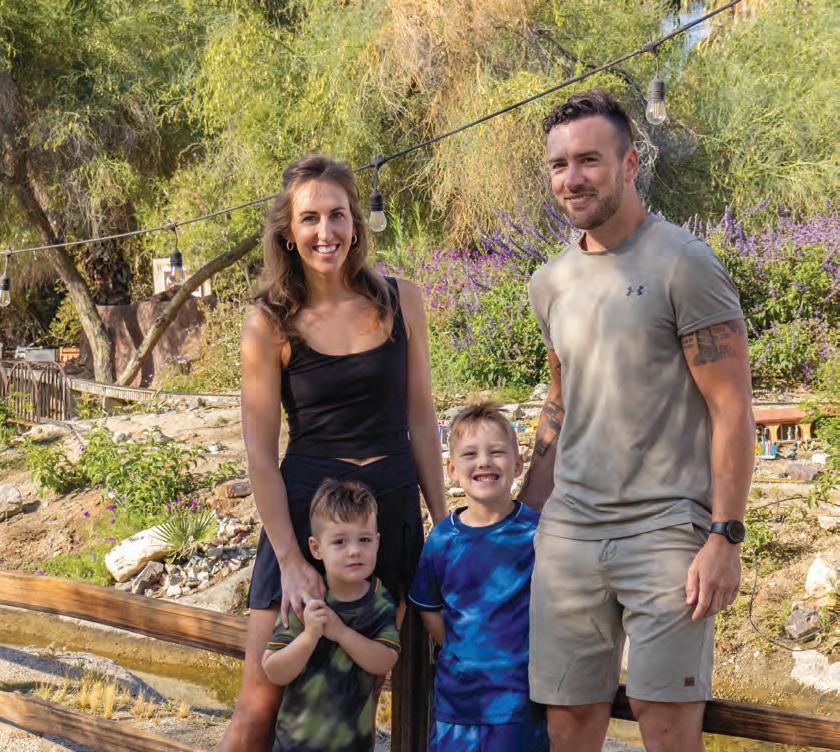
JA NI CE AND AUS TI N did not grow up in the Coachella Valley — but after marrying near Joshua Tree, they fell in love with the desert’s magic In 2018, they made Palm Desert their home, drawn by its beauty and community spirit. Janice, a dedicated physician associate at Desert Orthopedic Center, and Austin, a full-time dad and day trader, now raise their two boys just down the street from The Living Desert Zoo and Gardens
Their days often begin with tennis at Shadow Mountain Tennis Club, and end with bike rides to the Zoo, no car needed. “The Living Desert is our backyard,” they say. “We can go from breakfast to the front gate in under ten minutes.”
Zoo membership became a lifeline after their children were born. “It’s hours of entertainment for the boys and peace of mind for us,” Austin shares. From toddler classes
to splash pads and immersive exhibits, the Zoo offers more than fun it offers connection. “We’re not just visitors — we’re part of The Living Desert family,” Janice adds. “The staff know our kids by name It’s low-stress, high-reward, and always evolving.”
For this family, The Living Desert isn’t just a destination, it’s home
Do you remember your very first visit to The Living Desert?
We did not know what to expect our first time at the Zoo. We were both extremely impressed with the diversity of animals, size and quality of their habitats, the enrichment activities, and, above all, how accessible everything was. It felt as if we had snuck behind the scenes of a much larger zoo on Christmas morning: zookeepers, staff and volunteers were sharing their time and expertise with us
totally unprompted; there were no lines anywhere.
What does being a member at the Zoo mean to your family?
People think about the desert as a retirement community, but what many don’t realize is there is a vibrant, involved, young-family community as well, and for us, The Living Desert is a central meeting place. Everyone we know is a member, it’s a perfect spot for playdates, meeting classmates after school, or just running into new friends. Being a member opens an easy way to connect with the community in an environment that is as fun and stimulating for growing minds as it is for their parents.
How has the Zoo inspired your kids’ curiosity or interests?
The impact of the expansive train exhibit and the engagement of the train volunteers cannot be overstated. Our children have learned to watch for engine and car changes daily, hold discussions with adults and ask questions about the mechanics and difficulties unique to running trains in the desert, and then turn and teach us what they’ve learned. This has boosted their confidence and creativity — skills noted both by us and their teachers.
What would you tell someone who’s thinking about becoming a member?
Do it today! There is a world-class zoo hidden in a corner of our little Valley; you can spend your morning five feet away from the most majestic animals on Earth, then have lunch with some bighorn sheep, check out the model trains and still be home in time for a nap. There is no better investment for a desert resident than a membership at The Living Desert Zoo and Gardens.
EVENTS CALENDAR FALL/WINTER 2025
ONGOING
Season Hours Return
Starting October 1
The Living Desert returns to its regular operating hours of 8:00am-5:00pm daily, with last admission at 4:00pm. The hiking trails and carousel will also resume regularly scheduled operating hours.
Members’ Walking Club
Tuesdays and Thursdays, 8:00am-9:00am
Join The Living Desert’s members-only walking program and choose between a ¾ mile stroll or a 1¼ mile journey to enjoy the sights and sounds of the Zoo, alongside your fellow members. Visit LivingDesert.org/ Membership to become a member.
Me & You at the Zoo
Starting October 3:
Tuesdays and Fridays, 9:30am-10:30am
This interactive, parent participation program is designed for toddlers and their accompanying adults. This program is free with membership or paid park admission. No advance registration is required, so drop in anytime!
Happy Hour
Starting October 13:
Every Monday - Thursday, 3:00pm-5:00pm
Join us at Bighorn Cafe for exclusive drink specials and discounted bites! Access is included with your membership or paid park admission; food and beverages are an additional fee.
Coffee and Conservation
Starting October 4:
The first Saturday of the month, 9:00am-10:00am
Back by popular demand, this membersonly event offers you the unique opportunity to hear first-hand stories about conservation projects and in-field

Visit LivingDesert.org/Events or scan the QR code for more information about upcoming events.
adventures from the teams leading the charge – while enjoying a complimentary coffee and pastry! The event kicks off October 4 and will be held the first Saturday of each month running through April 4. Visit LivingDesert.org/Events to learn more.
Wild at Heart: ZooCamp for Adults
9:00am-12:30pm
October 17
November 14 December 12 January 23 February 20 March 20
The Living Desert is thrilled to offer ZooCamp for the young and wild at heart. During this unique adult camp, participants will discover the wonder of the deserts, with exclusive encounters, hands-on programming and even craft time! Registration is now open, visit LivingDesert.org/ZooCamp to learn more.
Howl-O-Ween
October 25, 26, 9:00am-3:00pm Celebrate the spooky season at the Zoo’s annual Halloween weekend event. Guests can enjoy family-friendly activities, costumes, trick-or-treat stations, and seasonal surprises at this fan-favorite celebration. This event is free for members or with paid park admission.
We’re going cashless
Starting October 1, The Living Desert will be a cashless facility.
For your convenience, reverse ATMs will be available on-site to convert cash to a prepaid debit card.
Learn more at LivingDesert.org/Visit
EVENTS CALENDAR FALL/WINTER 2025
Native Plant Sale
October 11, 9:00am-12:00pm
Purchase your own California native desert plants — propagated on-site at The Living Desert — to start your own home garden!
This plant sale is open to the public and does not include admission to the Zoo.
Fall ZooCamp
November 24-26, 8:30am-12:30pm
Three-day camp for grades K-6.
K-1: Little Vets
Join us for hands-on animal-themed fun, exploration, and learning.
2-3: Come Fly with Me
Learn why some birds migrate and how others adapt in our ever-changing world.
4-6: Global Guardians
Prepare to explore, learn, and become a champion for wildlife conservation!
Winter Mini ZooCamp
December 22 and 29, 8:30am-12:30pm
One-day camp for grades K-10.
Registration opens November 1, 2025
K-1: Wild Claws
Dive into the mysterious and majestic world of wild cats!
2-3: Animal Engineers
Learn more amazing examples of biomimicry, as well as other animal influenced gadgets and gizmos in this one-day camp.
4-6: Down to the Root
Get ready to dig deep, discover the science of gardening, and make a positive impact!
7-10: Beyond the Bite
Explore animal digestive systems, analyze dental structures, diets, and adaptations. Understand how zookeepers apply this knowledge for optimal animal care.
WildLights
Member Preview Night: November 24
Select Nights: November 25 - December 30
Returning for its 33rd season, this year’s WildLights brings new festive features along with seasonal fan-favorites.
World Desert Day
January 10
Celebrate the deserts of the world, along with all the flora and fauna that call them home, with special activities, tours, and connections..
International Desert Conservation Summit
January 16-18
Don't miss this eye-opening opportunity to hear first-hand stories from the world's leading conservation experts. Feautring Keynote Speaker, Paul Rosolie.
Travel with The Living Desert
Explore the world’s wild places with The Living Desert with exclusive experiences led by senior staff and local guides. Learn about the remarkable species you will see along your journey, and the conservation efforts to protect them. Each trip is hosted by knowledgeable experts and limited to only 16 travelers, making every excursion intimate and informative.
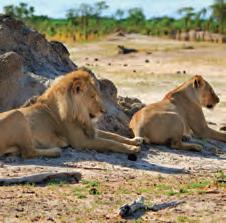
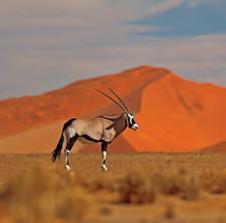

Visit LivingDesert.org/Travel to join us for Travel Night on November 4 and learn about our upcoming trips!
Kids
From a cardboard box to their fur-ever home, scan this QR code to see the roadtrip that brought the bobcats to the Zoo!

David and JoAnn! Welcome David and JoAnn!
For more on David and JoAnn, see page 6!
Wild LIGHTS
Member Preview Night
November 24
Select Nights
November 25 through December 30
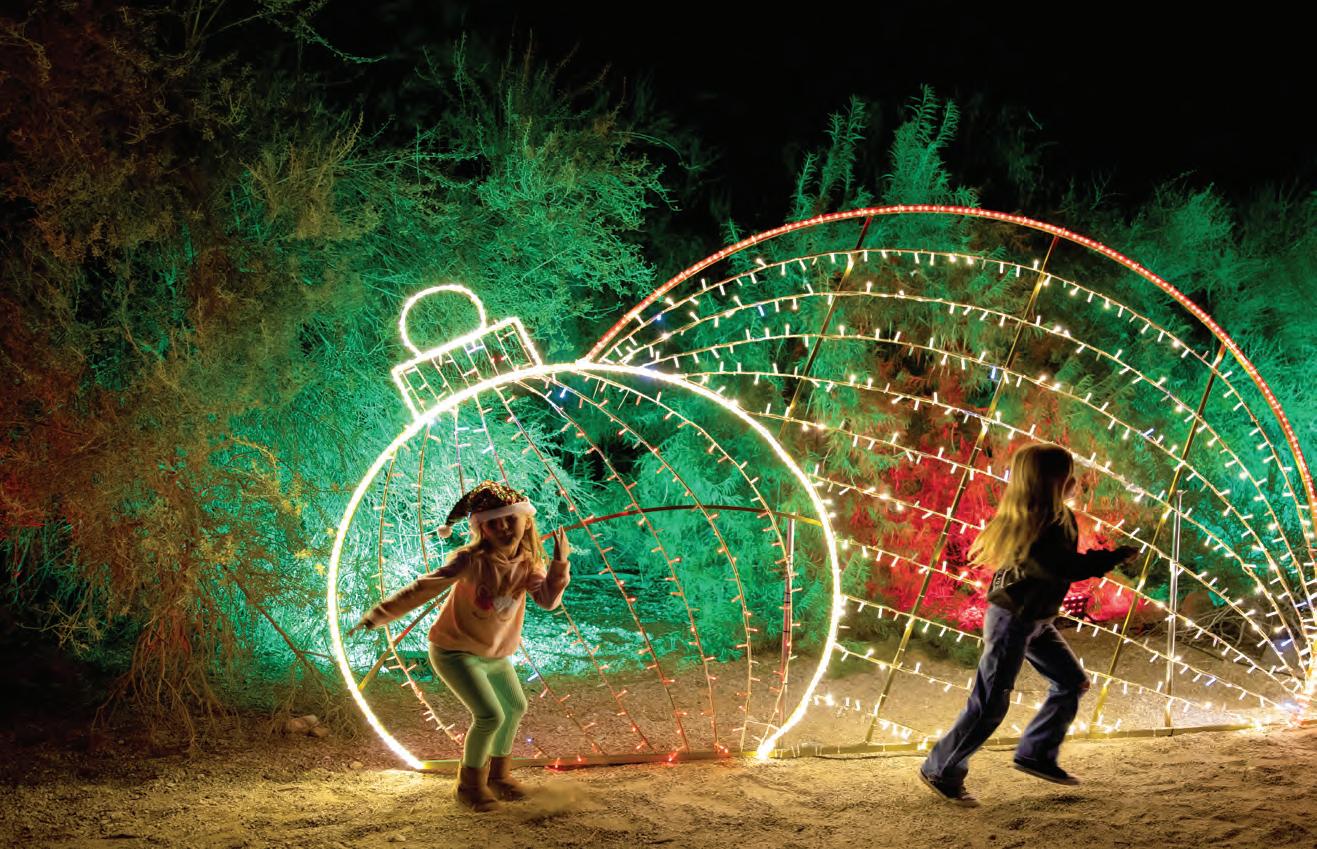
Tickets on sale soon!
The 33rd annual WildLights will feature festive fan favorites and sparkling new displays!
